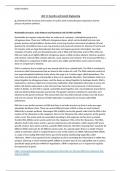Other
BTEC APPLIED SCIENCE UNIT11 - Learning aim A + B
- Institution
- PEARSON (PEARSON)
A: Understand the structure and function of nucleic acids to describe gene expression and the process of protein synthesis. B: Explore how the process of cell division in eukaryotic cells contributes to genetic variation. Grade Distinction.
[Show more]



